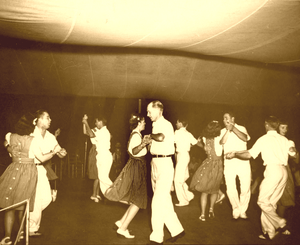Square dance facts for kids

Square dances are fun, energetic folk dances where four couples dance together in a square shape. Each couple stands on one side of the square, facing the middle. It's a bit like a puzzle where everyone moves together to create cool patterns!
Square dancing has a long history. People first wrote about these dances in the 1500s in England. They were also popular in France and other parts of Europe. When European settlers came to North America, they brought square dancing with them, and it became a big part of American culture.
Contents
What is a Square Dance?
A square dance is a type of sequence dance, meaning dancers follow a specific order of moves. It's not just about moving your feet; it's about working as a team with the other couples in your square.
The Caller and the Music
One of the most important people in a square dance is the "caller." This person shouts out instructions, telling the dancers what to do next. The caller uses a microphone so everyone can hear them over the music.
The music for square dancing is usually lively folk music, often played with instruments like fiddles, banjos, and guitars. The tempo is usually upbeat, which makes the dancing exciting and keeps everyone moving!
Basic Moves and Figures
Dancers learn a series of basic moves, like "allemande left," "do-si-do," and "promenade." The caller puts these moves together to create different "figures" or patterns. Even though there are many different calls, once you learn the basics, you can dance to almost any caller!
Square dancing is a great way to meet new people and get some exercise. It's a social dance, so you're always interacting with others in your square. It's also a fantastic way to experience a piece of history and tradition.
Images for kids
-
Quadrille variation involving five couples dancing at a Colonial Ball in the Albert Hall, Canberra September 2016 (sepia)
-
American-style square dancers performing outdoors in Schleswig-Holstein, Germany in 2014
See also
 In Spanish: Square dance para niños
In Spanish: Square dance para niños





